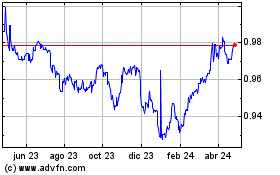Euro Falls As Eurozone PMI Hits 14-month Low, German Business Sentiment Worsens
22 Marzo 2018 - 12:58AM
RTTF2
The euro declined against its major rivals in the European
session on Thursday, as Eurozone business activity expanded at the
weakest pace in more than a year in March and German business
sentiment deteriorated, while European shares dropped ahead of U.S.
President Donald Trump's tariff announcement aimed at China.
Flash data from IHS Markit showed that the composite output
index dropped to 55.3 in March from 57.1 in February. The score
signaled the weakest growth in the private sector since January
2017.
The reading was expected to ease moderately to 56.8.
Survey data from Ifo institute showed that German business
climate index dropped to 114.7 from February's initially estimated
115.4. The score was forecast to fall to 114.6.
The current conditions index slid to 125.9, which was below the
expected level of 125.6.
Traders weighed the impact of Trump's plan to impose tariffs
against China worth upto $60 billion over intellectual-property
violations. The move is likely to spark retaliation from Beijing
and a trade war.
The currency held steady against its major rivals in the Asian
session, with the exception of the yen.
The euro weakened to near a 2-month low of 0.8704 against the
pound, from a high of 0.8742 hit at 3:45 am ET. The next possible
support for the euro is seen around the 0.86 level.
Figures from the Office for National Statistics showed that U.K.
retail sales rebounded at a faster than expected pace in
February.
Retail sales volume grew 0.8 percent month-on-month in February,
in contrast to a 0.2 percent drop in January. Sales were expected
to grow moderately by 0.3 percent.
Following an 8-day high of 1.2388 hit at 3:30 am ET, the euro
retreated to 1.2321 against the greenback. On the downside, 1.21 is
seen as the next support level for the euro.
The single currency slipped to a 9-day low of 1.1676 against the
Swiss franc, reversing from an early high of 1.1724. The euro is
poised to test support around the 1.15 level.
The 19-nation currency reversed from an early high of 131.02
against the yen, falling to a 3-day low of 130.15. Further
downtrend may see the euro challenging support around the 128.00
level.
Data from the Ministry of Economy, Trade and Industry showed
that Japan's all industry activity decreased for the first time in
four months in January, in line with expectations.
The all industry activity index fell 1.8 percent
month-over-month in January, reversing a 0.6 percent rise in
December.
The euro dropped to a 9-day low of 1.5844 against the loonie and
a 3-day low of 1.7010 against the kiwi, off its early highs of
1.5956 and 1.7110, respectively. If the euro falls further, it may
find support around 1.55 against the loonie and 1.67 against the
kiwi.
On the flip side, the euro held steady against the aussie, after
having advanced to 1.5975 at 12:45 am ET. The pair closed
Wednesday's trading at 1.5887.
Data from the Australian Bureau of Statistics showed that
Australia's jobless rate rose a seasonally adjusted 5.6 percent in
February.
That was above expectations for 5.5 percent, which would have
been unchanged from the January reading.
Looking ahead, at 8:00 am ET, the Bank of England's interest
rate decision is scheduled for release. Economists widely expect
the BoE to maintain interest rate at 0.50 percent and
asset-purchase program at GBP 435 billion.
The U.S. weekly jobless claims for the week ended March 17,
house price index for January, leading index for February and
Markit's manufacturing PMI for March are scheduled for release in
the New York session.
At 1:00 pm ET, the Bank of England Deputy Governor David Ramsden
delivers closing remarks at the International FinTech Conference in
London.
The Bank of Canada Deputy Governor Carolyn Wilkins speaks at the
Rotman School of Management in Toronto at 3:00 pm ET.
Euro vs CHF (FX:EURCHF)
Gráfica de Divisa
De Mar 2024 a Abr 2024

Euro vs CHF (FX:EURCHF)
Gráfica de Divisa
De Abr 2023 a Abr 2024
